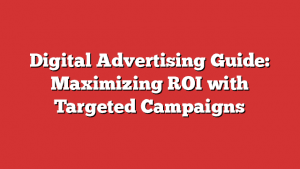- digital advertising guide
- 1. Importance Of Digital Advertising Plans
- 2. Greater Reach And Targeting With Digital Advertising
- 3. Real-Time Results And Measurable ROI With Digital Advertising
- FAQ
- What are the 4 steps of digital advertising?
- What is digital advertising a beginners guide?
- What is digital marketing guide?
- What are the 5 P’s of digital marketing?
In today’s fast-paced digital world, a well-crafted digitaladvertising strategy has become an essential tool for businesses to thrive.
As online platforms continue to evolve, capturing the attention of a specific audience has become both an art and a science.
This guide will unravel the secrets of effective digitaladvertising, unveiling the logic, cost, and real-time results behind these campaigns.
Get ready to dive into the world of digital advertising and discover the power it holds in expanding your reach and engaging your target market.
| Item | Details |
|---|---|
| Topic | Digital Advertising Guide: Maximizing ROI with Targeted Campaigns |
| Category | RTB |
| Key takeaway | In today's fast-paced digital world, a well-crafted digital advertising strategy has become an essential tool for businesses to thrive. |
| Last updated | December 30, 2025 |
guide">digital advertising guide
A digital advertising guide is a comprehensive plan that outlines the logic, cost, and strategies for online advertising initiatives.
It is important because digital advertising offers greater reach and targeting compared to traditional methods.
It provides real-time results and measurable return on investment (ROI).
A digital advertising plan should include advertising goals, a budget, a target audience, a timeline, advertising channels, messaging and creative strategy, and metrics for measuring success.
Regular review and adjustment of the plan based on results is crucial.
Understanding the target market and conducting a SWOT analysis helps in effective targeting.
Different avenues of digital advertising include paid search results, display ads, banner ads, and social media platforms.
Key performance indicators (KPIs) like conversion rate, click-through rate (CTR), cost per acquisition (CPA), and ROI measure the success of campaigns.
Tools like Adobe’s marketing plan template can be used to create engaging plans.
Digital advertising offers flexibility in terms of budget and scalability.
Unlike traditional advertising, digital ads can go live quickly, be changed even after the campaign starts, and allow for in-flight optimization based on performance.
They are accessible to smaller businesses despite potential cost.Key Points:
- Digital advertising guide outlines logic, cost, and strategies for online advertising
- Digital advertising offers greater reach and targeting than traditional methods
- Real-time results and measurable ROI are provided by digital advertising
- Key components of a digital advertising plan include:
- Goals
- Budget
- Target audience
- Timeline
- Channels
- Messaging
- Metrics
- Regular review and adjustment of the plan is crucial for success
- Understanding target market and conducting SWOT analysis aids in effective targeting
Check this out:
💡 Did You Know?
1. In the early days of digital advertising, the first banner ad ever displayed on the internet was sold by Wired magazine in 1994. The ad, which simply read “Have you ever clicked your mouse right here? You will.” had a click-through rate of 44%.
2. The average person is exposed to around 5,000 advertisements every day, making it more challenging for advertisers to capture and maintain consumers’ attention in the digital space.
3. The digital advertising industry accounts for a significant portion of global carbon emissions. In fact, a study found that in 2019, digital advertising was responsible for an estimated 3.7% of global greenhouse gas emissions, which is equivalent to the emissions produced by the entire aviation industry.
4. Remarketing, a popular digital advertising technique, can be traced back to a 2009 incident where a Google engineer named Susan Wojcicki mistakenly clicked on a digital ad for a pair of shoes. This led her to suggest the idea of serving targeted ads based on users’ previous online behavior, and eventually, remarketing was born.
5. Native advertising, a form of digital advertising that blends seamlessly with the content and design of a website, was actually pioneered by print publications. In the late 19th century, magazines like The Atlantic and Time magazine started incorporating advertising content that matched the overall look and feel of the publication, leading to the inception of native advertising as we know it today.
1. Importance Of Digital Advertising Plans
Digital advertising plans are essential in showcasing online advertising initiatives and their logic and cost. In today’s digital age, businesses must have a well-defined plan to effectively reach and engage their target audience. Without a clear strategy, digital advertising efforts can be haphazard and ineffective.
A well-crafted digital advertising plan serves as a roadmap, outlining advertising goals and objectives. It helps identify the target audience, determine the budget, select appropriate advertising channels, and develop an effective messaging and creative strategy. With a comprehensive plan, businesses can ensure their digital advertising initiatives align with overall marketing objectives and contribute to company success.
Additionally, a digital advertising plan provides clarity on proposed spending. It enables businesses to allocate resources wisely and make informed decisions on where and how to invest their advertising budget. By understanding the planned expenditure, businesses can minimize wastage and maximize their return on investment in digital advertising.
2. Greater Reach And Targeting With Digital Advertising
One of the key advantages of digital advertising over traditional advertising is its ability to offer greater and more targeted reach. Unlike traditional advertising mediums such as print or television, digital advertising allows businesses to precisely target their message to specific audiences based on demographics, interests, behavior, and more.
Digital advertising platforms provide businesses with advanced targeting options that enable them to reach their ideal customers with precision. By utilizing data-driven targeting techniques, businesses can ensure that their ads are seen by the right people at the right time, increasing the chances of conversion and generating a higher return on investment.
In addition to targeting capabilities, digital advertising also provides businesses with the opportunity to reach a global audience. With internet users spanning across the globe, businesses can expand their reach beyond their local market and tap into new customer segments. This opens up a world of opportunities for businesses to grow their brand and increase their market share.
- Greater and more targeted reach compared to traditional advertising
- Precise targeting based on demographics, interests, behavior, and more
- Advanced targeting options for reaching the ideal customers
- Data-driven targeting techniques for increased conversion and ROI
- Global audience reach beyond local market
- Opportunity to tap into new customer segments
“Digital advertising allows businesses to precisely target their message, increasing the chances of conversion and generating a higher return on investment.”
3. Real-Time Results And Measurable ROI With Digital Advertising
Digital advertising offers real-time results and measurable return on investment (ROI) compared to traditional advertising methods. This means that businesses can track and analyze the performance of their campaigns in real-time, enabling them to make data-driven decisions and optimize their advertising efforts for maximum ROI.
By utilizing various analytics and tracking tools, businesses can gain insights into metrics such as click-through rate (CTR), conversion rate, cost per acquisition (CPA), and more. These metrics provide valuable information about the effectiveness of advertising efforts, helping businesses make informed decisions about resource allocation.
Optimized content based on recent advertiser behavior.
The ability to measure the ROI of digital advertising campaigns allows businesses to refine their strategies and invest in initiatives that yield the highest returns.
FAQ
What are the 4 steps of digital advertising?
Step 1: Establish a compelling website that serves as the foundation for your digital marketing efforts. A well-designed website is crucial for converting site visitors into potential customers.
Step 2: Drive traffic to your website through various marketing tactics. Utilize strategies such as search engine optimization, social media advertising, and content marketing to attract potential customers to your site.
Step 3: Focus on customer retention by providing valuable content, excellent customer service, and personalized experiences. Engaging with your audience and building strong relationships will increase customer loyalty and encourage repeat business.
Step 4: Continually evaluate the success of your digital advertising strategy. Regularly analyze key metrics and gather insights to understand what’s working and what can be improved. Adjust and optimize your strategy accordingly to ensure continued growth and success.
What is digital advertising a beginners guide?
Digital advertising is a beginner’s guide to promoting products or services online. In today’s digital age, it is crucial to incorporate search advertising and display ads into your marketing strategy. Search ads allow you to reach a wider audience by targeting specific keywords that potential customers may be searching for, increasing your chances of being found. Display ads, on the other hand, showcase visually appealing and engaging advertisements on various websites and platforms, making your brand more visible and attracting potential customers. By understanding and utilizing these essential components, you can pave the way to success in the digital advertising landscape.
What is digital marketing guide?
A digital marketing guide serves as a comprehensive resource that helps individuals and businesses navigate the world of digital marketing. It provides insights, strategies, and tactics on how to effectively utilize various digital assets to increase brand visibility, attract customers, and drive sales. The guide typically encompasses a wide range of topics such as website creation, email marketing, and search engine optimization, offering valuable guidance on leveraging these strategies to enhance brand engagement and achieve desired business outcomes. Whether you’re a beginner or an experienced marketer, a digital marketing guide serves as a valuable tool to stay up-to-date with the latest trends and best practices in this ever-evolving field.
What are the 5 P’s of digital marketing?
In the realm of digital marketing, the 5 P’s take on a new perspective. Firstly, Product remains crucial, but now includes the digital offering itself, whether it’s a mobile app or a website. Price becomes more dynamic as digital platforms enable personalized pricing strategies and real-time adjustments. Promotion expands beyond traditional advertising to include social media, content marketing, and influencer partnerships. Place shifts to the digital landscape, where targeting specific online platforms and optimizing user experience are paramount. Lastly, People now encompasses the digital audience, where understanding and connecting with customers on various digital channels is critical for success.
Performance Marketing Tips • Native Ad Network • Advertising Platform for Marketers • Buy Traffic











